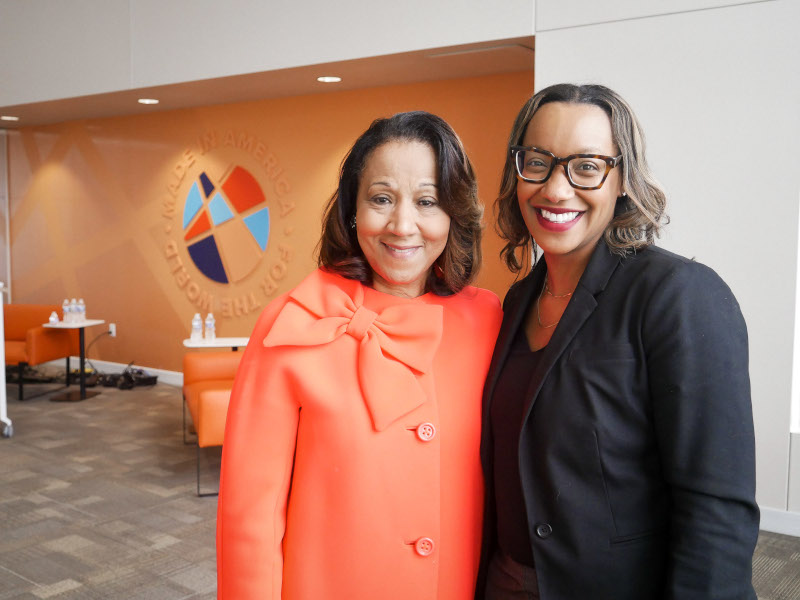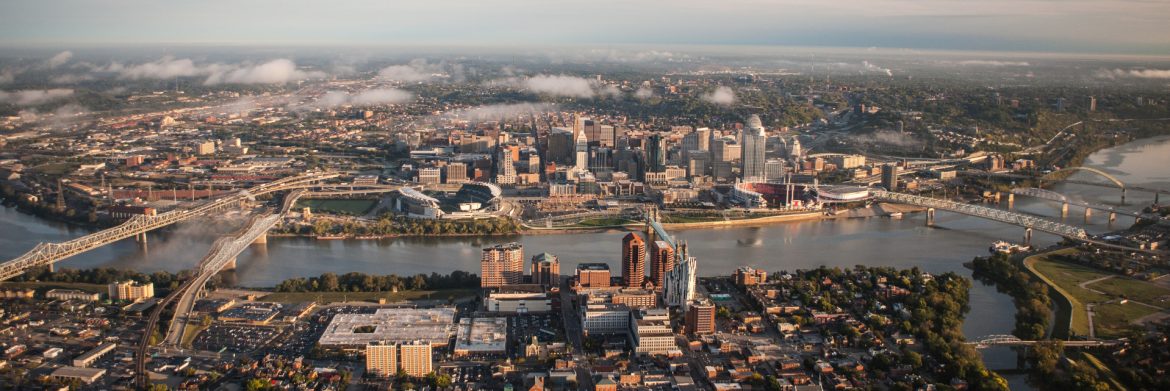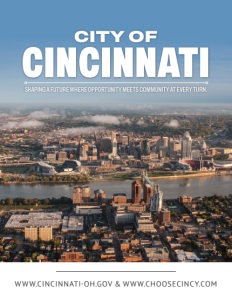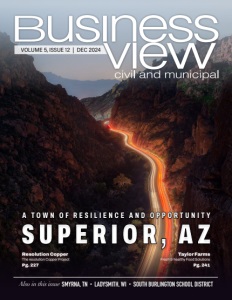Cincinnati, Ohio
Shaping a Future Where Opportunity Meets Community at Every Turn.
This much loved city has ambitious plans for infrastructure, affordable housing, and strategic industry growth
Cincinnati, Ohio, is rich in history, innovation, and a bustling community spirit. Known for its distinctive blend of Midwestern charm and urban sophistication, the city has become a regional hub for culture, business, and sports. With 52 unique neighborhoods, it’s where high-powered companies are headquartered, and a thriving arts scene coexists with deep appreciation for tradition. Residents enjoy a city that’s accessible and alive with energy.
Mayor Aftab Pureval beams with pride when talking about his city. “I could drop you in the middle of our urban core, and you’d be within walking distance of incredible experiences,” he says. Cincinnati’s compact urban center is brimming with life, from restaurants led by James Beard finalists to architectural landmarks.
He highlights the Contemporary Arts Center, designed by the renowned Zaha Hadid— “The New York Times called it the most important building designed after World War II.” For sports fans, the options are endless: you could catch an AFC Championship game, an MLS playoff, or see the Reds play at their scenic riverfront ballpark.
The proximity of cultural, corporate, and civic assets creates an environment that Mayor Pureval believes is uniquely suited to opportunity. “Procter & Gamble, one of the largest consumer products companies in the world, is right here. Kroger, GE Aerospace, Cincinnati Children’s Hospital—it’s a concentration of resources that you won’t find in many places, especially not at our cost of living,” he says. Reflecting on his own journey—from newcomer to mayor in less than a decade—he insists that “this story of opportunity and achieving your dream is only possible in Cincinnati.”
Mayor Pureval is also quick to point out that Cincinnati is ready to meet the labor challenges head on and boasts educational pathways to achieve this. With the University of Cincinnati at its doorstep, families can find first-class educational opportunities at home. The university has launched its new 1819 Innovation Hub newsletter which represents a playbook for igniting creativity and driving change, providing insights and tools into how to achieve innovation success.
Tradition runs deep in Queen City, and sports serve as a powerful thread, binding generations together. “Opening Day for the Reds is more than just a game,” Mayor Pureval explains. “The whole city basically shuts down—it’s a civic celebration.” Cincinnati’s Oktoberfest, one of the largest outside Munich, celebrates the city’s Germanic roots with a multi-day food, beer, and live entertainment festival. “Next year, we’ll be the first city in the country to celebrate the nation’s 250th anniversary,” Mayor Pureval notes. The America’s River Roots Festival centers on the Ohio River, paying homage to the diverse cultures and generations that its influence has shaped.

Director Carter with Emerge Manufacturing CEO Cynthia Booth on the day of the ribbon-cutting for the new PPE manufacturing plant in Cincinnati’s Bond Hill Neighborhood. Photo Credit: Kate Leubkeman
Downtown Development and Small Business Growth
In Cincinnati, the downtown area is the pulse of a regional economic engine that ripples across Ohio and beyond. For Mayor Pureval, investing in this urban core is essential. “Downtown doesn’t just affect our city economy; it has a profound impact on the regional and even statewide economy,” he explains. With the Cincinnati Metropolitan Statistical Area (MSA) being the largest in Ohio, city leaders bear a unique responsibility to sustain downtown’s energy and walkability.
Mayor Pureval and the city’s Administration have taken a proactive approach to address the changing dynamics of work and urban life. “Remote work is here to stay, so we quickly adopted a strategy to transform underutilized office space into housing,” he notes. Through initiatives like state-funded brownfield remediation and city-backed investments, Cincinnati is repurposing non-Class A office buildings to meet growing residential demand. Projects like the former Macy’s building, which is being converted into over 300 units of workforce housing, are reshaping downtown’s identity. Likewise, the old Saks department store building is being redeveloped to house a new Paycor headquarters, a restaurant, and premium office space.
The city’s investment doesn’t stop at housing and office space. With a $600 million upgrade planned for the convention center and a new 650-800 room global hotel in the works, Mayor Pureval sees downtown Cincinnati becoming a magnet for tourism and international events. “Last year, Taylor Swift and Lionel Messi came through Cincinnati, and we’re a finalist to host Sundance for the next decade,” he says, noting how these big draws have put Cincinnati on the map.
For the small businesses that form the foundation of Cincinnati’s identity, the city has created programs designed to address their unique challenges. “Small businesses are the fabric of our city,” says Markiea Carter, Director of the City’s Department of Community and Economic Development. To support them, the city rolled out a capital improvement grant program to help businesses with the high costs of building out their spaces, one of the biggest hurdles for local entrepreneurs, allowing business owners to focus their resources on operational expenses and workforce.
Equity is a cornerstone of Cincinnati’s approach to economic development, especially in supporting minority-owned businesses. Mayor Pureval speaks to the barriers many minority and women entrepreneurs face when accessing capital and expertise. “Minority and women small business owners need capital and mentorship,” he explains. To meet this need, the city partnered with local organizations like the African American Chamber and the Urban League, contributing $3 million to the Lincoln and Gilbert Fund.
Cincinnati’s tech ecosystem, which Mayor Pureval describes as “thriving,” is also a focus for the city’s development efforts. Black Tech Week, an annual event highlighting Black tech entrepreneurs and creators, has become a marquee celebration in Cincinnati. “We’re incredibly proud of the pipeline of Black tech talent here,” the Mayor says, noting that this growing sector significantly impacts the city’s entrepreneurial landscape.
Strategic Growth in Key Sectors
Mayor Pureval identifies healthcare, technology, consumer products, and insurance as cornerstones of Cincinnati’s economic landscape, but he also highlights a rapidly growing opportunity in logistics. “Transportation and logistics are expanding quickly,” he explains. The Cincinnati/Northern Kentucky International Airport hosts the largest DHL hub in North America, and the city’s strategic location enables companies to reach 60% of the U.S. population within a six-hour drive. Additionally, Cincinnati is investing in a $4 billion bridge along I-75, a key artery for the national economy, carrying 3% of the U.S. GDP each year.
Beyond logistics, Cincinnati’s proximity to Intel’s new semiconductor plant in central Ohio is creating ripple effects throughout the region’s economy. “We’re preparing to attract supply chain investments by redeveloping brownfield sites along the I-75 corridor,” Mayor Pureval says.
Working with The Port of Greater Cincinnati Development Authority and major employers, the city is transforming abandoned industrial property into shovel-ready sites to support the anticipated influx of tech and manufacturing opportunities.
The city’s recent incentives in the healthcare sector are already yielding significant returns. Carter points to Medpace, a contract research organization recently expanding with city support. “The city extended a generous incentive package to Medpace as they build a new tower in the Madisonville neighborhood,” she explains. This expansion adds high-paying jobs to the local economy and reinforces Cincinnati’s position as a medical research and development leader. Similarly, she highlights Emerge Manufacturing, an African American-owned and women-owned business located on the former Cincinnati Gardens site; City-backed incentives were key in spurring the transformation of the historic but long-vacant site into a modern manufacturing hub for medical protective equipment.
As Cincinnati ramps up its economic development, workforce readiness remains a priority. Carter notes that workforce initiatives align with corporate and community partners, from local universities to major employers. “For projects like Emerge Manufacturing, the owner has committed to hiring locally,” she says, emphasizing the City’s focus on creating jobs in historically underserved neighborhoods and ensuring its residents can take advantage of the opportunities created by these new and expanding businesses.

Crowds of all ages gather to watch a light art exhibit during the Blink light-art festival in fall of 2024. Photo Credit: Kate Leubkeman
Transforming Infrastructure and Expanding Housing Access
For Cincinnati, infrastructure investment offers an opportunity to reshape the city’s future and address past inequities. Mayor Pureval credits the bipartisan infrastructure bill as a game-changer, unlocking federal funds for monumental projects like the Brent Spence Bridge. “We secured a $1.6 billion grant, the largest in the country’s history, to finally make progress on the bridge,” he says, describing the investment as a catalyst for regional economic growth. This new bridge will connect Ohio and Kentucky along I-75 and facilitate critical reinvestment in the West End, a historically Black neighborhood disrupted by previous infrastructure projects.
Another bold move by the city was the decision to sell the Cincinnati Southern Railway, a railroad asset owned by the city for over 150 years, to create a sustainable funding stream.
“We sold it for $1.6 billion to create a trust fund that will generate $50 million in interest annually,” the Mayor explains.
Facing a $400 million deficit in capital infrastructure needs, the city saw this as a way to address gaps in basic maintenance while freeing up funds for forward-looking projects in housing and other essential services. With this trust fund, Cincinnati has secured a perpetual revenue source to support its infrastructure, from repaving roads to maintaining public parks.
Addressing Cincinnati’s housing shortage is another pressing priority for city leaders, especially as the city’s population grows. Carter explains that the pandemic accelerated efforts to convert underused office spaces into residential units, a strategy to address the housing demand in and around the downtown core. “We recognized early on that Cincinnati was facing a housing shortage, so we mobilized to incentivize office-to-residential conversions,” she says. In tandem with these conversions, the city has also established an Affordable Housing Trust Fund in partnership with the Cincinnati Development Fund, which pools public and private resources to create affordable housing.
The “Connected Communities” legislative initiative recently passed through Council set a foundation for Cincinnati’s approach to housing, with plans to increase residential development throughout the city’s business districts and transit corridors. Carter describes this initiative as a comprehensive effort to leverage additional investment into new housing, focusing on building infill properties on vacant lots, and making it easier to rehab existing buildings. “We’re looking at ways to create two-, three-, and four-family housing units—something Cincinnati desperately needs,” she says. Collaborating with neighborhood development groups, abandoned spaces, like vacant grocery stores and bowling alleys, have been transformed into hundreds of affordable housing units that enrich the community.
Cincinnati’s Vision for the Future
In the coming months, Cincinnati is zeroing in on the issues that could define its future growth: infrastructure improvement and accessible housing. Mayor Pureval lays out a focused agenda for his administration to maximize the impact of the city’s newly created $1.6 billion trust fund. “My team and I will make sure these funds address our most critical infrastructure needs, so residents feel the benefits directly,” he says.
Another top priority for the mayor and his team is tackling the city’s housing crisis head-on. With recent changes to Cincinnati’s zoning code and a streamlined approach to incentives, the city has set the stage to accelerate housing development. Mayor Pureval sees this as crucial for maintaining Cincinnati’s growth trajectory while ensuring that new housing options remain accessible. “We’re pairing our new zoning code reforms with gap financing to make housing available at every income level,” he explains.
Mayor Pureval notes that lack of affordable housing is an “existential threat” to the city’s future. Without decisive action to control costs and expand supply, he worries that Cincinnati risks losing the momentum it has built. His administration’s decisions over the past two years—selling the city-owned railway, securing unprecedented federal funds, and updating zoning laws—are bold moves with long-term implications. Now, the mayor says, comes the hard part: demonstrating that these strategic shifts will yield results for Cincinnati’s residents.
For the mayor and his administration, the next 18 months will hopefully prove that these calculated risks were worthwhile. In a city poised for transformation, these practical, impactful investments could define Cincinnati’s growth and secure its place as a city that is not only well loved, but also firmly on the rise.
AT A GLANCE
City of Cincinnati
What: Bold urban revitalization through infrastructure investment, housing expansion, and business growth
Where: Cincinnati, Ohio
PREFERRED VENDORS
University of Cincinnati 1819 Innovation Hub – innovation.uc.edu
The University of Cincinnati’s tradition of innovation and discovery burns bright at the 1819 Innovation Hub. Located at the nexus of industry and higher education amid the burgeoning Cincinnati Innovation District, 1819 is transforming the future.
Accelerating ideas from conception to fulfillment, the 1819 Innovation Hub links corporate partners and promising startups with UC’s talent and resources. Thanks to a collaboration between 1819’s community members, an outpouring of creative brilliance flows from our space.
The UC Ground Floor Makerspace inspires creatives and innovators as they design pioneering tech using 3D printers and advanced fabricating equipment.
In the Esports Innovation Lab, skilled gamers compete and livestream their triumphs in the broadcast booth.
Entrepreneurs flock to UC’s Venture Lab searching for wisdom about launching startups. After 28 cohorts, the team understands what early-stage founders need to thrive.
The 1819 Learning Lab enriches and enlivens corporate teams facing roadblocks. Industry experts improve company structures by stimulating personal growth and innovative thought.
Researchers and industry partners head to the Technology Transfer team for patenting help and wisdom while navigating commercialization.
There’s nearly limitless potential at the 1819 Innovation Hub. Come and you’ll discover the inventive, inspiring energy that makes 1819 Where Next Happens.



